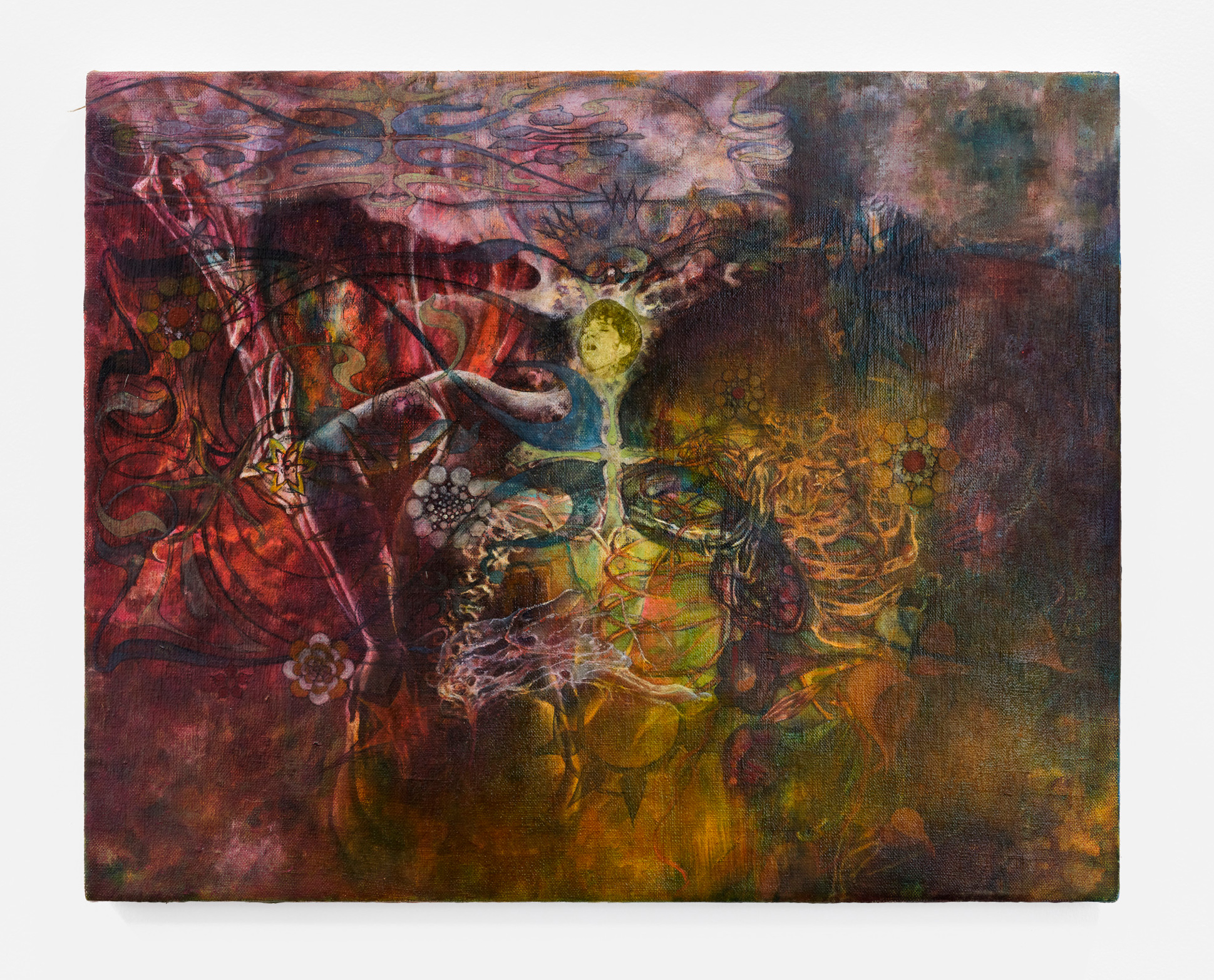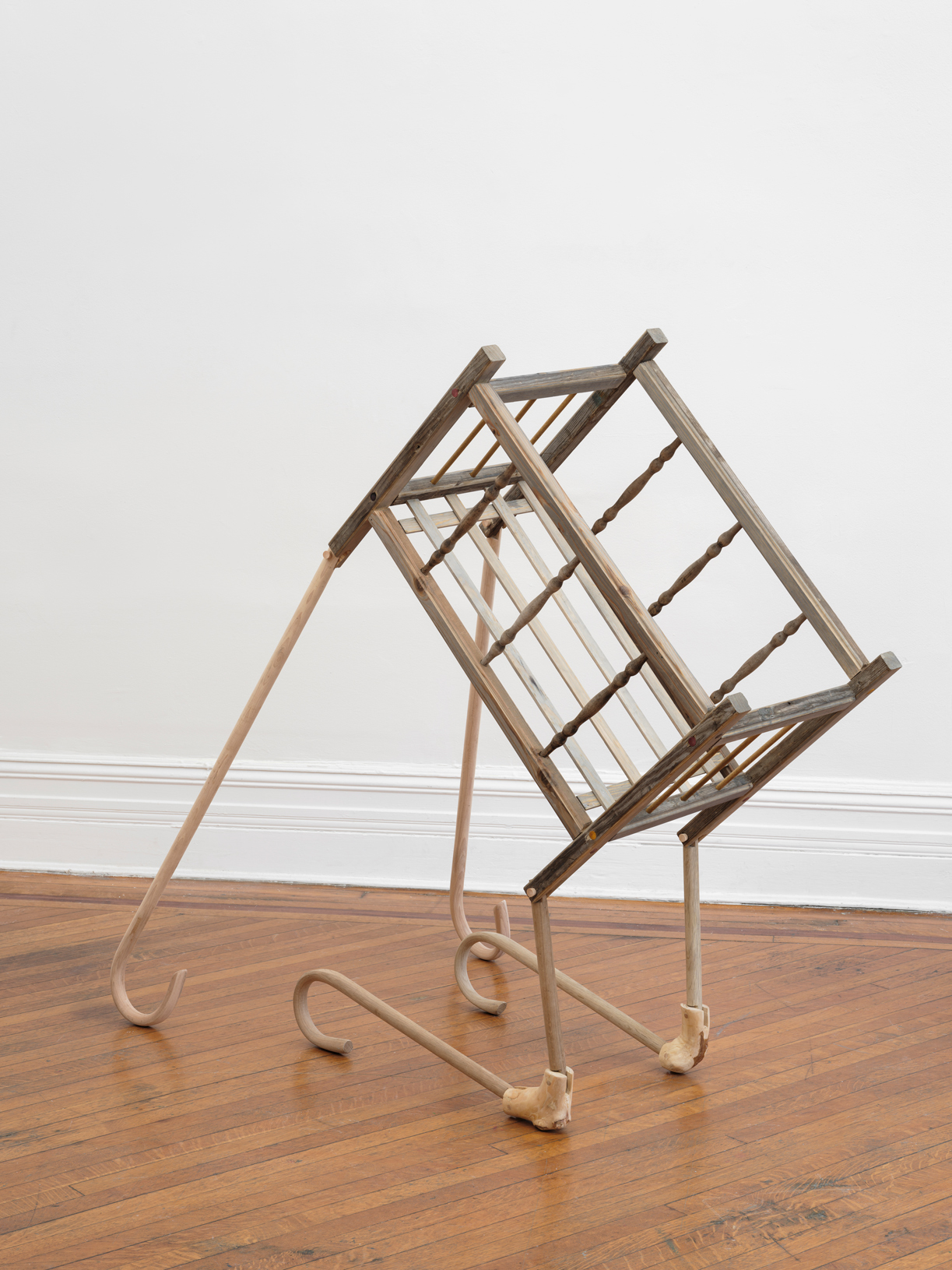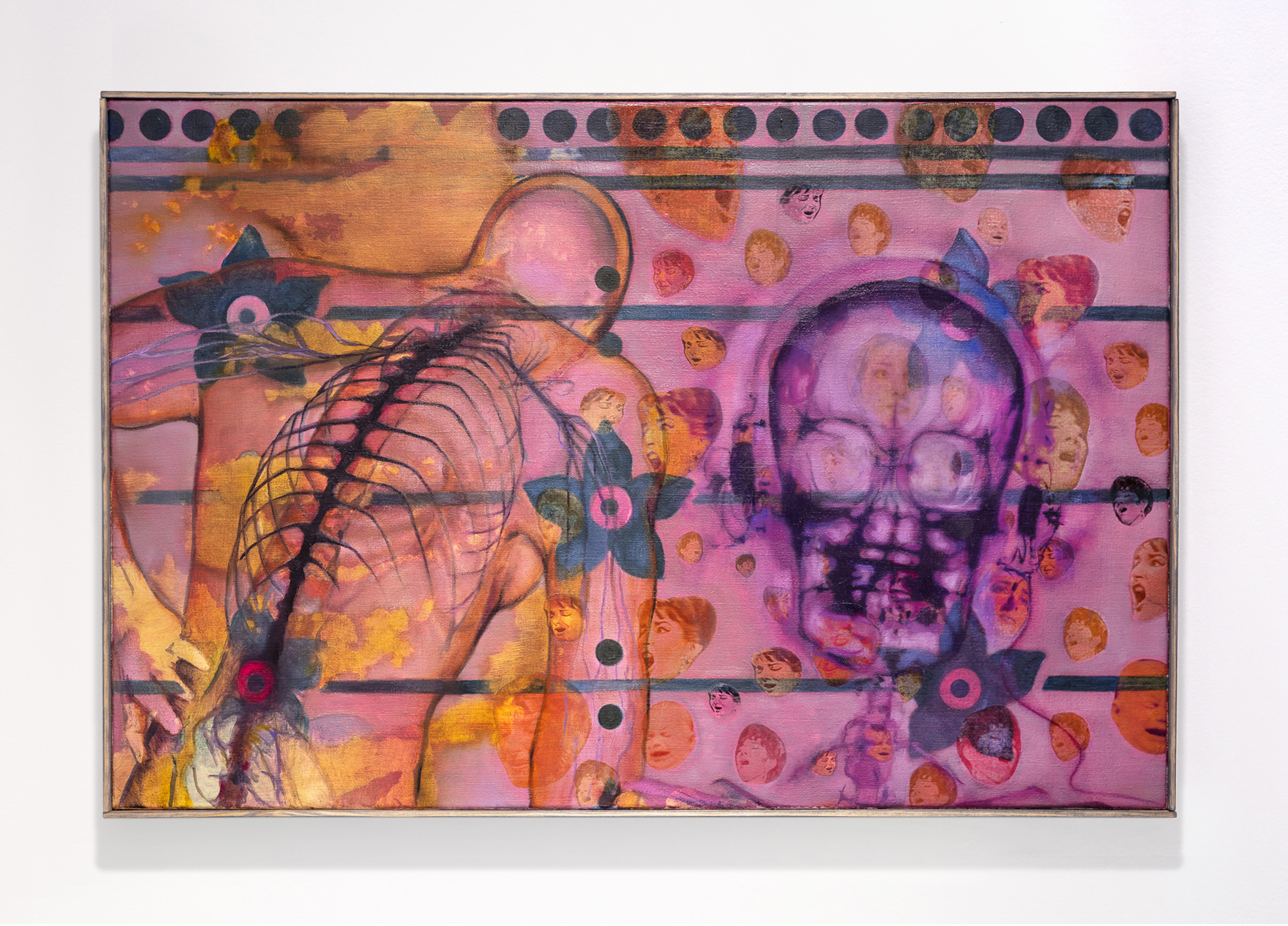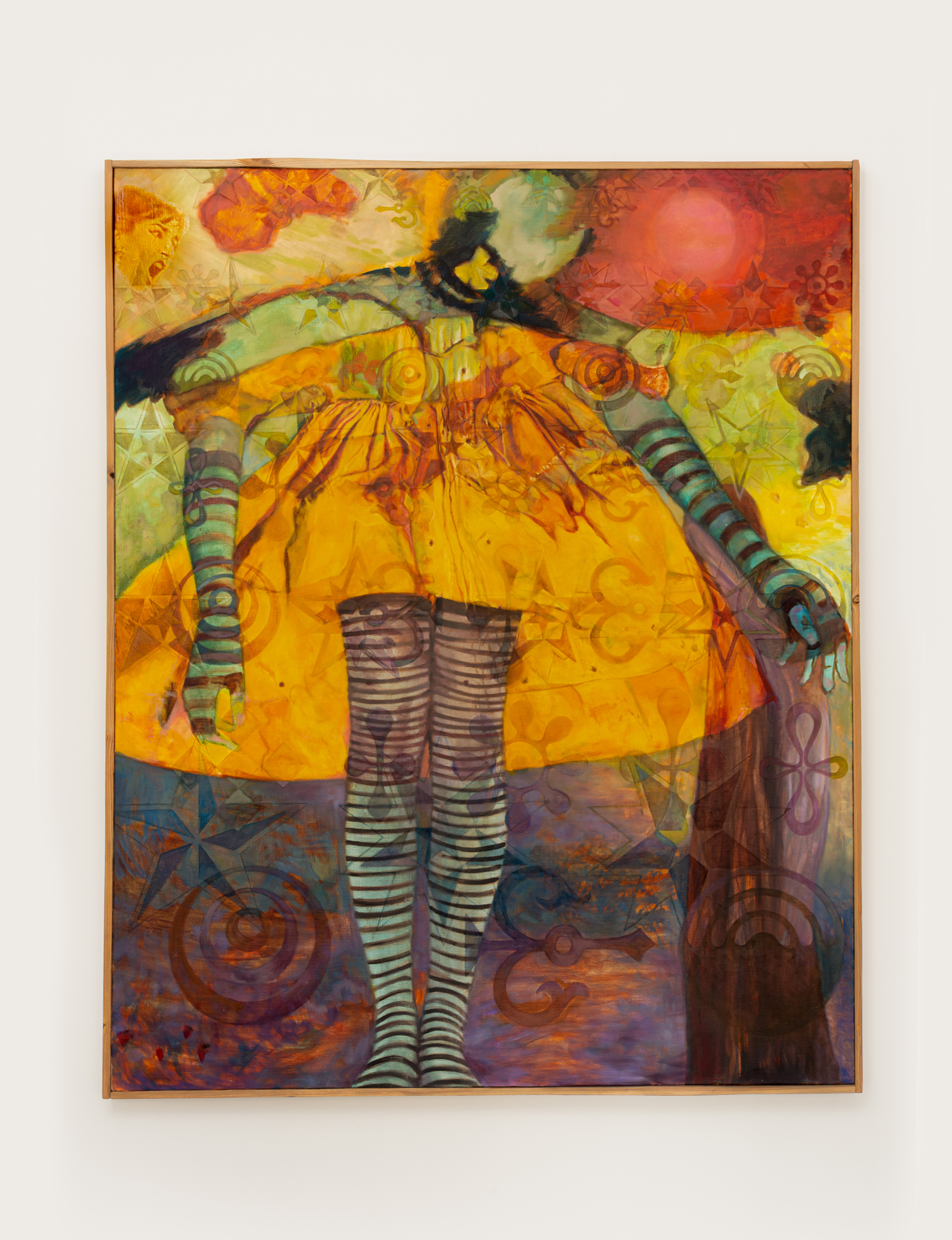Alexandra Metcalf and the totalities of current life
A take on the recent artworks by New York-based Alexandra Metcalf: the crafts, the themes, the feels, the wonders
Complexity rules the art of Alexandra Metcalf the same way it rules the cycle of life. We live through infancy, we come of age, we mature and die: a process that could be effortless, were it not for the emotional, bodily, and semantic obstacles we or others put in front of us. Peter Wessel Zapffe said humans are overequipped for this life – too clever for what they need to go through – but forgot about the pleasure of being lost, wondering. Standing in front of a Metcalf painting, there is a certain feeling of wonder, its richness taking you by surprise.

Born in the UK in 1992, growing up between London and Florida, Metcalf currently lives in New York, managing a studio in her home. Interested in crafts from a young age, she toys with woodworking and stained glass for her sculpture beside her painting and assemblage. She told me she sometimes wishes she lived in Los Angeles, [1] where one can weld metal or fire glass in their backyard without running into major trouble with the law.
Life as a symbolically rich process of becoming something else is one of the threads that bind many of Metcalf’s works. They subtly evoke the idea of change. They are snippets from a Bildungsroman, a German word she mentioned during our conversation to indicate precisely the narrative arches we all experience. She doesn’t simply describe them though, being far from observing without commenting. Her approach to life-storytelling flows over into criticism of life the way it is, especially from a feminist perspective. If things are this way, it doesn’t mean they should be. For example, the nuclear in the nuclear family becomes a nuclear cloud in her 7hz, 2022: a psychedelic sky delimits a landscape populated with symbols, from a woman screaming/singing (we’ll get back to her), to bas-reliefed Arts & Crafts flower motifs, and a mouth. Lips are dusty symbols of femininity but are also the exit through which the voice leaves the body and gates for the body to nourish itself.

The concept of a total work of art came back multiple times when we spoke. Though not quite the Romantic Gesamtkunstwerk, the idea that a man – Wagner in particular – could percolate all of the artistic forms into a final artistic experience so encompassing that no further pursuit of intellectual achievement is needed. According to the man, art history came to an end in Bayreuth. Metcalf is ambitiously less naive. A direct reference to Wagner’s theater even exists in her work: Bayrueth Hush, 2023, shows layers of bubbles and waves that form a maelstrom whose center features the recurring woman singing and screaming (we will get back to her). The title refers to that moment of suspense we feel before a play begins, described by a 19th century word “hush”. (For titles she is fond of 19th century, Victorian expressions she collects from a dictionary.) After the hush, when the painting appears, it is a sort of big bang with a human in the middle, dense like sentience.

Metcalf likes to render the cycle of life sculpturally too. The works Crib 1 and Crib 2, both 2023, consist of assemblages of specifically made and repurposed objects: raw lumber cribs, walking sticks, spindles, buttons. They resemble creatures in their pose, standing up healthy in Crib 1 or leaning down under the weight of the years in Crib 2. The newborn life in the crib, whose potential feels infinite, faces reality in the pose of a creature no longer able to walk, but possibly just taking a rest by a pond–Metcalf mentioned she modeled the body posture in Crib 2 from a giraffe drinking. The cycle closes, life and death coexisting.
From description, Metcalf’s art might feel melancholic, existential even, yet the real life experience of her works is far from that. Take her painting Retrokink, 2023, where figures bluntly emerge from another iteration of her psychedelic palette. We see the back of a body, clearly suffering in her spine, a red dot aching right on the lower back: an old person perhaps, or young but in existential pain. The skull next to the figure is not so much a symbol of death as it is one of wellness: show and know your inner workings to heal yourself. The skull has headphones on, music hitting its inner chords to cause emotional if not physical reactions). We enter the territory of new age spirituality, where body and spirit merge through self-imposed discipline. Old Californian hippies come to mind as much as adolescents dreaming of utopia/free love, but also milieus such as Brit punk zines–she is a collector of those. In short, the subcultures of yesteryear and today claim much of Metcalf’s painterly territory, whether through hinted aesthetics or straightforward references.

We can finally reveal the identity of the screaming and singing recurring character, which multiplies in Retrokink. That is Maria Callas, the Greek opera singer, somewhat an ambassador of a long gone jet-set generation of women who pushed it to the limit. Opera writer Jenna Simeonov writes: “Callas says with no ambiguity that a woman’s true calling in life is to have a family and a husband. This, from a successful career woman who could have stood for the great feminist movement to come.” This vetust personage dominates the paintings, often dialoguing with references to later, critical feminism in art: think of the gendered clothes reminiscent of Isa Genzken (Labile, 2023) or a play on distorted body forms typical of Sarah Lucas (Coloratura, 2023).

A Liste Showtime webpage recently provided a good insight into Metcalf’s studio, focusing on a few objects she pinned on the wall or simply holds dear. Described in first person with no lack of anecdotes, they profile an artist who is attracted to a form of ad-hocism that leaves space to mystery. One finds a butterfly roughly built out of a late 1990s Nokia cell phone and repurposed kitchenware, a Turkish dancer lamp belonging to her superstitious grandmother, a kind of self-built videogame watch. She mentioned she is animistic, ascribing special qualities to inanimate objects. Her artist frames made out of historical, salvage scrap wood from the turn of the century – scavenged from SawKill Lumber in New York – speak to that.

If representation of people features in most of Metcalf’s art, her sculpture Daddy! Daddy!, 2022, is quite possibly the most anthropomorphic approximation. A man is depicted with crooked walking sticks as legs, a century old millinery block to shape his hat, small skeletons with pacifiers, perhaps hinting at his innocent youth. While she describes the work to me, I am brought back to her studio I previously visited online: a picture of her real father hangs on the wall, silkscreened by her artist mother in the pop art style. Things have changed.
[1] All the quotes attributed to the artist originate from a conversation with this writer in June 2023.
September 22, 2023
